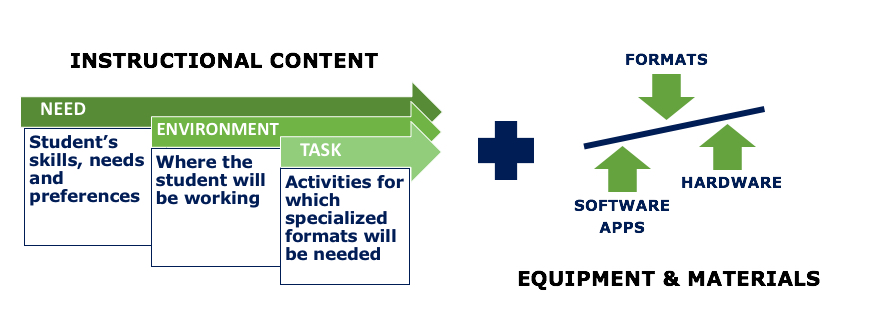AIM Considerations
What are the considerations for AIM?
Considerations for AIM involves a student-centered approach to reading. This approach consists of the instructional content in which a student is to read as well as the equipment and materials that may be used. A number of formats, software/apps, and hardware are available for accommodating a wide range of students. It is important to note that even students who have the same disability classification on their educational plan, may benefit from completely different configurations of AIM.

Model based off the SETT framework (Zabala).
Instructional Content
The instructional context portion of the student-centered approach is a tiered decision-making process that focuses on the individual needs of a student. Addressing each tier helps to ensure that appropriate equipment and materials are selected to accommodate student needs.
Need: Student’s skills, needs and preferences
While each student’s need will be unique, the following questions may help as a starting point.
- Does the student struggle with standard printed text?
- Might they benefit from an alternate version of the same reading presented in a different medium or with additional supports?
- Do they have an aptitude for auditory comprehension; read aloud or using digital tools?
- This approach will help educators and parents to make informed decisions when deciding if and what tools will benefit their students.
Environment: Where the student will be working
It is important to note where the student will be reading. It might seem trivial, but without knowing the environment, one can potentially choose ineffective tools. Depending on a student’s needs and reading location, environmental considerations might include:
- levels of light or sound
- access to electricity for charging equipment
- internet speed
A student may very well benefit from entirely different reading configurations when doing so in the classroom, at home, or on the bus.
Task: Activities for which specialized formats will be needed.
Activities of reading vary throughout a student’s educational experience. They can take place incidentally as well as during planned times through the day. The following questions may assist in identifying tasks where AIM may be beneficial to students.
- When will the student need to engage with text?
- Is it only textbooks and literature where the student has difficulty reading?
- Would the student benefit from alternatives to reading classroom worksheets, instructions, the internet, and tests?
- Will students be reading independently? Will they be reading in groups?
- Is the student required to do silent reading, locate the main character, answer questions, or student for an upcoming test?
Equipment & Materials
Once the instructional content is considered for a student, it’s important to explore the tools that may help to accommodate and support reading. At AIM-VA, these tools consist of software/apps, hardware and formats. All three must be compatible and work together for a student to read successfully.






